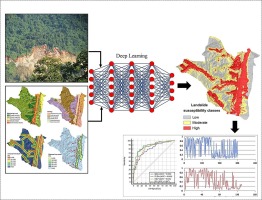Catena ( IF 5.4 ) Pub Date : 2020-01-08 , DOI: 10.1016/j.catena.2019.104451 Dong Van Dao , Abolfazl Jaafari , Mahmoud Bayat , Davood Mafi-Gholami , Chongchong Qi , Hossein Moayedi , Tran Van Phong , Hai-Bang Ly , Tien-Thinh Le , Phan Trong Trinh , Chinh Luu , Nguyen Kim Quoc , Bui Nhi Thanh , Binh Thai Pham

|
With the increasing threat of recurring landslides, susceptibility maps are expected to play a bigger role in promoting our understanding of future landslides and their magnitude. This study describes the development and validation of a spatially explicit deep learning (DL) neural network model for the prediction of landslide susceptibility. A geospatial database was generated based on 217 landslide events from the Muong Lay district (Vietnam), for which a suite of nine landslide conditioning factors was derived. The Relief-F feature selection method was employed to quantify the utility of the conditioning factors for developing the landslide predictive model. Several performance metrics demonstrated that the DL model performed well both in terms of the goodness-of-fit with the training dataset (AUC = 0.90; accuracy = 82%; RMSE = 0.36) and the ability to predict future landslides (AUC = 0.89; accuracy = 82%; RMSE = 0.38). The efficiency of the model was compared to the quadratic discriminant analysis, Fisher's linear discriminant analysis, and multi-layer perceptron neural network. A comparative analysis using the Wilcoxon signed-rank tests revealed a significant improvement of landslide prediction using the spatially explicit DL model over these other models. The insights provided from this study will be valuable for further development of landslide predictive models and spatially explicit assessment of landslide-prone regions around the world.
中文翻译:

用于滑坡敏感性预测的空间显式深度学习神经网络模型
随着不断发生的滑坡的威胁越来越大,磁化率图有望在促进我们对未来滑坡及其规模的理解中发挥更大的作用。这项研究描述了用于预测滑坡敏感性的空间显式深度学习(DL)神经网络模型的开发和验证。根据来自Muong Lay区(越南)的217个滑坡事件生成了一个地理空间数据库,为此导出了一组九个滑坡条件因子。采用Relief-F特征选择方法来量化条件因子在开发滑坡预测模型中的效用。几个性能指标表明,就训练数据集的拟合优度而言,DL模型均表现良好(AUC = 0.90;精度= 82%; RMSE = 0。36)和预测未来滑坡的能力(AUC = 0.89;精度= 82%; RMSE = 0.38)。将模型的效率与二次判别分析,Fisher线性判别分析和多层感知器神经网络进行了比较。使用Wilcoxon符号秩检验进行的比较分析显示,使用空间显式DL模型进行滑坡预测的效果明显优于其他模型。这项研究提供的见解对于进一步开发滑坡预测模型和对世界范围内易发生滑坡地区进行空间明确评估将具有宝贵的价值。和多层感知器神经网络。使用Wilcoxon符号秩检验进行的比较分析显示,使用空间显式DL模型进行滑坡预测的效果明显优于其他模型。这项研究提供的见解对于进一步开发滑坡预测模型和对世界范围内易发生滑坡地区进行空间明确评估将具有宝贵的价值。和多层感知器神经网络。使用Wilcoxon符号秩检验进行的比较分析显示,使用空间显式DL模型进行滑坡预测的效果明显优于其他模型。这项研究提供的见解对于进一步开发滑坡预测模型和对世界范围内易发生滑坡地区进行空间明确评估将具有宝贵的价值。










































 京公网安备 11010802027423号
京公网安备 11010802027423号